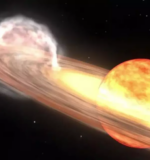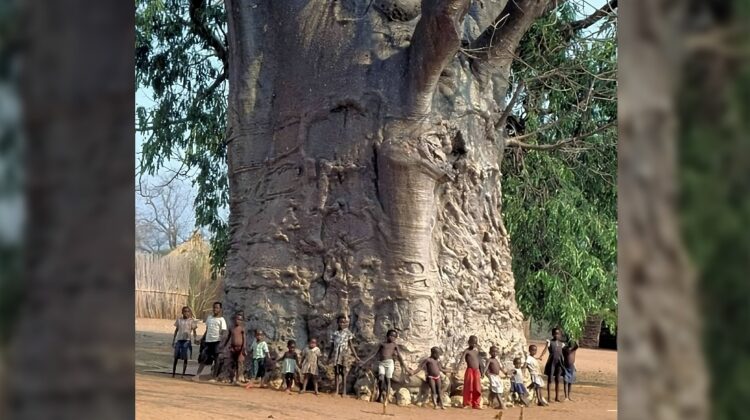“It’s a once-in-a-lifetime event that will create a lot of new astronomers out there, giving young people a cosmic event they can observe for themselves, ask their own questions, and collect their own data,” said Rebekah Hounsell, an assistant research scientist specializing in nova events at NASA’s Goddard Space Flight Center in Greenbelt, Maryland. “It’ll fuel the next generation of scientists.”

A conceptual image of how to find Hercules and the “Northern Crown” in the night sky, created using planetarium software. Look up after sunset during summer months to find Hercules, then scan between Vega and Arcturus, where the distinct pattern of Corona Borealis may be identified.
NASA
Heads up sky gazers, this summer, a rare once in a lifetime event is anticipated to occur, resulting in professional and amateur astronomers alike becoming fixated on on one small constellation deep in the night sky.
Located among the seven stars of Corona Borealis, within the “Northern Crown,” the rare event is a dark spot where an impending nova will occur—so bright it will be visible on Earth with the naked eye, NASA says. Known as the T Coronae Borealis, dubbed the “Blaze Star” and known to astronomers simply as “T CrB,” it is a binary system nestled in the Northern Crown approximately 3,000 light-years from Earth.

NASA/Goddard Space Flight Center
The system is described as an Earth-sized remnant of a dead star with a mass comparable to that of (our) sun called a white dwarf.
“An ancient red giant slowly being stripped of hydrogen by the relentless gravitational pull of its hungry neighbor,” NASA said. “The hydrogen from the red giant accretes on the surface of the white dwarf, causing a buildup of pressure and heat. Eventually, it triggers a thermonuclear explosion big enough to blast away that accreted material. For T CrB, that event appears to reoccur, on average, every 80 years.”
The last time the T CrB nova was seen from Earth was in 1946, and the first record of it was more than 800 years ago. “In the autumn of 1217, Burchard, abbot of Ursberg, Germany, noted his observance of ‘a faint star that for a time shone with great light.’
A nova differs from a supernova, which is an explosion that destroys dying stars, NASA explains. During a nova event, the dwarf star remains intact and sends accumulated material hurtling into space in a blinding flash. The nova cycle typically repeats itself over time as a process that can carry on for thousands of years.
“There are a few recurrent novae with very short cycles, but typically, we don’t often see a repeated outburst in a human lifetime, and rarely one so relatively close to our own system,” Hounsell said. “It’s incredibly exciting to have this front-row seat.”
Researchers say if the current T CrB nova pattern continues, the nova event could occur by September 2024. When the event occurs, the outburst will be brief. However, once it erupts, it will be visible to the naked eye for a little less than a week. “I’m confident it will be quite a sight,” Hounsell added.








 Photographer Finds Locations Of 1960s Postcards To See How They Look Today, And The Difference Is Unbelievable
Photographer Finds Locations Of 1960s Postcards To See How They Look Today, And The Difference Is Unbelievable  Hij zet 3 IKEA kastjes tegen elkaar aan en maakt dit voor zijn vrouw…Wat een gaaf resultaat!!
Hij zet 3 IKEA kastjes tegen elkaar aan en maakt dit voor zijn vrouw…Wat een gaaf resultaat!!  Scientists Discover 512-Year-Old Shark, Which Would Be The Oldest Living Vertebrate On The Planet
Scientists Discover 512-Year-Old Shark, Which Would Be The Oldest Living Vertebrate On The Planet  Hus til salg er kun 22 kvadratmeter – men vent til du ser det indvendigt
Hus til salg er kun 22 kvadratmeter – men vent til du ser det indvendigt  Superknepet – så blir snuskiga ugnsformen som ny igen!
Superknepet – så blir snuskiga ugnsformen som ny igen!  Meteorite That Recently Fell in Somalia Turns Out to Contain Two Minerals Never Before Seen on Earth
Meteorite That Recently Fell in Somalia Turns Out to Contain Two Minerals Never Before Seen on Earth  Nearly Frozen Waves Captured On Camera By Nantucket Photographer
Nearly Frozen Waves Captured On Camera By Nantucket Photographer  It’s Official: Astronomers Have Discovered another Earth
It’s Official: Astronomers Have Discovered another Earth 
why not try these out phantom Extension
look here rabby wallet download
canadian online pharmacy
Замечательная мысль
independent therefore, whether you are a fan of esports or a player who makes bets on classic varieties sports, Thunderpick https://smi.hamburg/site/2025/01/09/the-advanced-guide-to-aviador-betwinner/.
Диплом пту купить официально с упрощенным обучением в Москве
Официальная покупка диплома вуза с сокращенной программой обучения в Москве
online canadian pharmacy
мегафон подключить
https://ekb-domasnij-internet-3.ru
провайдер мегафон
КОНЦОВКА КЛАССНАЯ!!!!!!!!!!!!!!!!!
21 декабря 2020). Дата обращения: 28 декабря 2020. Архивировано 22 декабря 2020 http://uym.my.coocan.jp/bbs/bbsm/bbs1.cgi?aaa& года.
поддельный аттестат купить
Viagra super active plus http://northwestpharmacydrugstore.com/ Tadalista vs cialis
На этом сайте доступны свежие новости России и мира .
Здесь можно прочитать важные новостные материалы на различные темы.
https://ecopies.rftimes.ru/
Следите за важнейших новостей в любое время.
Надежность и актуальность в каждом материале .
На этом сайте доступны актуальные новости РФ и всего мира.
Представлены значимые репортажи по разным темам .
https://ecopies.rftimes.ru/
Следите за главных событий ежедневно .
Проверенная информация и оперативность в каждой публикации .
Как работает суррогатное материнство: от выбора клиники до рождения ребенка
поиск сурмамы http://www.mammalogy.su/ .
Компания 1хБет предоставляет всем 100% бонус за первый депозит до 32500 рублей (или эквивалент в другой валюте по актуальному курсу). Кроме того, вас ожидает приветственный пакет в 1xBet казино до €1950 +150 фриспинов для игры в слоты и игровые автоматы. 1xBet — это одна из самых популярных и надежных платформ, которая предлагает уникальные возможности и привлекательные бонусы для своих пользователей. Независимо от того, являетесь ли вы новичком в мире ставок или опытным игроком, промокоды 1xBet — это отличный способ повысить свои шансы на выигрыш.
Промокод 1xBet
https://piganddac.com/news/1hbet__1xbet__promokod_2020___bonus_6500_rubley.html
Промокод 1хБет на сегодня – предоставляет вам возможность получить 100%-й бонус до 32 500 ? и Приветственный пакет до 1500 евро + 150 фриспинов для игры в разделе азартных игр 1хБет. 1xBet — это известная онлайн-платформа для ставок, которая славится своими щедрыми бонусами и привлекательными предложениями. Если вы ищете уникальный игровой опыт и дополнительные шансы на успех, то бонусы 1xBet станут отличным выбором для вас.
Бонусы являются одной из главных особенностей, которые делают 1xBet привлекательной для множества игроков. Как новый, так и постоянный пользователь, вы сможете воспользоваться различными видами бонусов, которые помогут увеличить ваши шансы на выигрыш. От приветственных бонусов до регулярных акций, 1xBet предлагает множество вариантов, чтобы удовлетворить ваши потребности и предпочтения.
Один из самых популярных бонусов, предоставляемых 1xBet, – это приветственный бонус для новых игроков. Как только вы зарегистрируетесь на платформе, вам будет предложен щедрый приветственный пакет, который включает в себя бонус на первый депозит. Это означает, что вы получите дополнительные средства на свой игровой счет, чтобы увеличить свои возможности для ставок. Такой бонус является отличным стартом в вашем игровом путешествии и помогает вам исследовать различные игры и спортивные события.
The clip, which was filmed in the course of the fourth collection back in 2006, shows him rehearsing with actress Georgina.
https://zenwriting.net/cmf6ausus1
supreme supplies in india
Curiously, we generally tend to square measure at home with a lot of the metals for a whole lot of years and that they nonetheless are very important as requirements for our life.
https://cadillacsociety.com/users/xzUPOt
купить диплом о высшем образовании москва
canadian pharmacy no prescription
Generic Cialis Online Pharmacy Reviews First medicine online pharmacy store Cheap viagra pills for sale order cialis without prescription Medicine online 24
sky pharmacy reviews
Antipsychotic drugs such as risperidone (risperdal®), aripiprazole (abilify®), ziprasidone (geodon®) and quetiapine (seroquel®) can be used to reduce aggression, irritability, https://piscinadiala.it/relax-in-piscina/ , as well as other behavioral problems concerning autism.
zdx4qe
3tggd9
bl2kge
3dtu9r
24ny3v
wqeqpn
acrg2w
вшивание торпеды от алкоголизма вшивание торпеды от алкоголизма .
Купить диплом в Архангельске
In truth, our mind can be an ideal memory.
https://fab-chat.com/members/JFIEJjZ/profile/
The Historic Printing Society publication removes Thomson’s notes from the appendix and as an alternative presents them in footnote type all through the work, based on the original plates to which they refer.
http://www.tend-uqygdv.xyz/blog/1737794425120